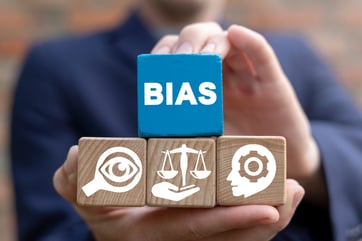The House of Mirrors
Making decisions without clarity is like trying to navigate the House of Mirrors at a carnival. Information, facts, and inputs get stretched and skewed and distorted such that what we see is not the truth. We stumble around trying to find our way through, sometimes bumping into walls, making wrong turns, and can end up back where we started.
This is good fun at the carnival, but it’s a nightmare for leadership - time consuming, costly, wasteful, and frustrating. Around every turn is a new surprise.

We need to work to turn the mirrors into windows that we can see clearly through.
In communication technology these distortions are called interference, effects that modify a signal in a disruptive manner. Interference has two sources in business:
- Personal interference which includes personal cognitive models, perspectives, assumptions, habits, and biases.
- Organizational interference involving unvoiced perspectives, information filtering (intentional and unintentional), structures and lines of reporting, and lack of systems for accurate and timely information capture.
To minimize surprises and make the best possible decisions, leaders must remove the interference and dismantle the House of Mirrors. They need to work to remove both personal and organization factors that interfere with the timely and accurate flow of information.
Assumptions and Biases
How often do we think back to an experience and berate our past selves saying, “I should have seen that coming?” The story of Nortel we wrote about recently, When Giants Fall is an example of a series of biases and assumptions that went unchecked and contributed to the firm’s eventual demise.
The saying, assumptions make an ass out of ‘u’ and ‘me’, is a helpful epigram, but it doesn’t tell the entire story. Yes, assumptions can lead us astray, but without them human beings would not be able to function. We assume the alarm we set will wake us up in the morning, we assume our car will start, we count on most if not all the groceries on our list being in stock at the store. If we had to stop and rethink every one of the thousands of assumptions-based decisions we make each day, we would be paralyzed by analysis.
The trouble is not the assumption as much as when the assumptions we make turn out to be wrong. Therefore, to avoid surprises, whenever possible assumptions should be tested and validated.
Further, assumptions need to always be made explicit and documented. Just like with the scientific method, we should list our assumptions when making decisions or choosing actions. Too often we look back on a past decision and we are unable to remember what the rationale was because we can’t recall our assumptions.
More insidious and often more costly are biases. Where assumptions are conscious choices about what information we choose to filter or ignore, bias is the unconscious filtering of information or truths. Biases skew the way we see reality or the way we think.
“Research consistently shows that humans are hardwired to dismiss information that doesn’t fit our worldview and select for information that does.”
Michael Easter, author of The Comfort Crisis
Not all filtering is bad. Filtering and selective attention plays a crucial role in tuning out the many stimuli that deluge our senses constantly.
 Scientists are now finding that one of the most important functions of our brain is filtering so that we can focus. We can listen to a single person speaking in a noisy room, spot the slotted, orange handled screwdriver on our cluttered workbench, or feel when we connect with the sweet spot of our tennis racket during a running backhand. In each of these examples, our brains are filtering hundreds of other inputs so we can focus our attention on one. It is now believed that suppressing information is a much more primal, deeper function of the brain than processing information.
Scientists are now finding that one of the most important functions of our brain is filtering so that we can focus. We can listen to a single person speaking in a noisy room, spot the slotted, orange handled screwdriver on our cluttered workbench, or feel when we connect with the sweet spot of our tennis racket during a running backhand. In each of these examples, our brains are filtering hundreds of other inputs so we can focus our attention on one. It is now believed that suppressing information is a much more primal, deeper function of the brain than processing information.
There is a popular selective attention video online that demonstrates just how powerful the filtering function of our brain is (search ‘selective attention gorilla’). While a team of individuals is passing a basketball, the voice-over announcer asks us to focus and count how many times the ball is passed. As we count the passes, we are totally oblivious to the gorilla costumed individual that walks into the frame, beats his chest, and walks out.
If we are going to do our best work as leaders to surprise-proof our organizations, we need to become students of bias. We need to understand not just how bias influences our view of the world, but how they play a role in how others see reality and function cognitively.
“The reality is that important decisions made by intelligent, responsible people with the best information and intentions are sometimes hopelessly flawed.”
Andrew Campbell, et al, Harvard Business Review
 How many biases are there? Psychologists and social scientists are still studying this question, with some lists enumerating 160 or more. Some are common and familiar like confirmation bias (putting more value on information or perspectives that confirm our existing beliefs) and the sunk cost fallacy (irrationally clinging to something we’ve already invested in) while others are far less familiar. One of our favorites is the aptly named IKEA Effect, a bias in which people place a disproportionately high value on products they partially created or built.
How many biases are there? Psychologists and social scientists are still studying this question, with some lists enumerating 160 or more. Some are common and familiar like confirmation bias (putting more value on information or perspectives that confirm our existing beliefs) and the sunk cost fallacy (irrationally clinging to something we’ve already invested in) while others are far less familiar. One of our favorites is the aptly named IKEA Effect, a bias in which people place a disproportionately high value on products they partially created or built.
The extent to which bias can skew our views is astounding, and there are many studies and research projects that demonstrate this. For example, in an experiment undertaken at Simon Fraser University in Vancouver, a group of students were divided into three groups with each group given three conditions regarding an SFU branded coffee mug – a Seller Group expected to sell the mug they had at the best price, a Buyer Group expected to purchase a mug at the best price, and a Chooser Group that could either take the mug or take money instead. Each group was allowed to examine the mug and given a series of prices. Objectively, the Sellers and Choosers are in identical situations. When asked to decide, the average Seller would only sell at $7.12 or above, while the average Buyer would only pay $2.87 (Choosers would take $3.12 or more, or the mug if less).
This experiment demonstrates endowment bias, the tendency of people to put a higher value on things they already have or own. Branded coffee mugs are trivial objects, but this effect is present in all types of business situations including buying or selling products, capital equipment, materials, companies, stocks, and other investments. For instance, business owners looking to sell their companies almost always feel the firm is more valuable that what potential buyers think.
Turning Mirrors into Windows

As leaders there are several things we can do to remove or minimize the impact of assumptions and biases:
-
Keep a decision roster for all key decisions that document the supporting data and assumptions for the decisions made.
-
Stay humble. Continue to be curious and open to new information and perspectives. As Adam Grant told us, think like a scientist and be willing to rethink beliefs in the face of new information.
-
Foster a culture of safety. Acknowledge and appreciate people who bring differing opinions to the table, especially when those points-of-view are unpopular.
-
As often as possible go to the source of information. Want customer input? Talk to customers. Need to understand the issues of front-line workers? Visit branches and sites and even work there for a day. If possible, mystery shop or be a consumer of your company’s products and services.
-
Surround yourself with diversity. Diversity in culture, race, and backgrounds as well as diversity of behavioral styles and approaches. Leaders surrounded by so called, ‘yes men’ are usually not hearing the truth.
Unleashing the Potential of Your Organization
If you’d like to learn more about how to improve information flow and make better decisions, or other ways you can take the simpler path to creating a great business, connect with us or consider attending one of our upcoming leadership events.



